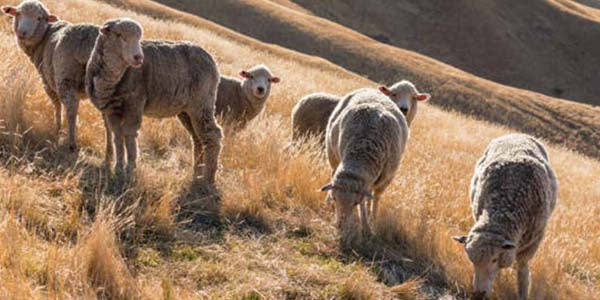
Why is Merino wool so expensive?
Australia is the leader in Merino wool farming, but where does Merino wool come from? Dating right back to 1797, the first Merino Sheep arrived in Australia from Spain’s flocks of Royal Merino sheep. Although these sheep already had fine fibres, Australian breeding made the fibres even finer.
Australia’s Merino wool industry is the most advanced in the world. Behind every Merino wool garment are thousands of people responsible for its production. The industry is so meticulous that you can trace the wool right back to the land it came from.
Why is Merino wool expensive? The thing with Merino wool is, it’s an investment, but you need to understand why it is. Firstly, Australian Merino wool is the most highly regarded Merino in the world because we have the ideal climate and conditions for breeding superior quality wool, and our wool industry is dedicated to environmental and social responsibility. For high-quality Merino wool to be produced, happy and healthy sheep are essential.
Australian farmers are dedicated to providing the correct nutrition and environment for the animals and ensure their health, behaviour and mental state is well looked after. As an Australian brand that values quality, this is hugely important because we only use Australian grown Merino for the softness and comfort it provides for babies and young children. But caring for Australia’s prized Merino sheep doesn’t always come easy or cheap, climate change is a massive contributor to the cost of Merino wool.
Drought and bushfires impact the cost of Merino
One of the most considerable impacts on the Australian Merino wool industry has been the record-breaking drought and bush fires. While Australia has the ideal climate and conditions for breeding superior quality Merino wool, the recent impacts of global warming and weather conditions have made it difficult for farmers.
Climate change has seen increased incidences of fire and drought, the outcome of this being the substantial destocking or loss of flocks. Farmers have had to destock as an affordability measure; it’s just too expensive to feed the sheep when the pastures and water have dried up. To recoup this loss of income, the farmers must increase their prices.
The Department of Agriculture, Water and Environment confirmed that it is already apparent that climate change is affecting fire weather. Season after season fires wipeout livestock, or leave them with blackened, unusable wool. It’s these scenarios which cause a steady increase in prices, and unfortunately, the fires are only going to get worse as Australia gets drier and hotter.
Quality affects the price of Merino wool
Although Merino sheep are resilient, malnourishment can affect the quality of their wool. Sheep grow less wool due to seasonal conditions, their bodies using what nourishment they have to survive the harsh climate. Drought and bushfires also bring about dust and dirt into the wool, discoloured wool, charcoal contaminated wool and burnt wool. When the quality of wool is affected, it means the high-quality Merino is scarce and expensive. For any brand willing to maintain its reputation for high-quality Merino wool, paying this higher price is a necessity.
Want fine, soft Merino wool? You’ve got to pay for it.
There isn’t just one type of Merino wool; Merino wool has different levels of thicknesses in the fibre. The Merino bloodline and where the sheep are from, determine the thickness of the wool. The finer the wool, the less itchy it is, the softer it is, and the more expensive it is.
- Fine wool Merino (19.5 microns and below) – Grown in northern and southern tableland areas of New South Wales, the western and southern districts of Victoria and the midlands of Tasmania.
- Medium wool Merino (20.6–22.5 microns) – Grown in the broad pastoral areas of New South Wales, Queensland, Victoria, South Australia and Western Australia.
- Strong wool Merino (22.6 microns and upwards) – Grown in western New South Wales, Queensland, South Australia and Western Australia.
What is the best wool. Merino or Regular Wool?
If the cost of Merino wool is at the mercy of environmental factors, wouldn’t it be best to change to regular wool? No, definitely not. There is a difference between regular wool and Merino wool; it’s why Merino wool is the best wool in the world. It comes down the Merino fibres; they are significantly finer than standard sheep wool, standard wool is heavier and bulkier.
This fineness is what makes Merino wool luxuriously soft and not scratchy like regular wool, particularly important for baby’s and children’s skin which is more sensitive than adult skin. The fine fibres make Merino lightweight yet perfect for keeping warm, layering and wearing all year-round. This is why at Hello Night, all our Merino pyjamas and layers use the finest grade Merino fibres for uncompromised softness and comfort. There’s nothing worse than stiff and bulky yarn that is scratchy on young delicate skin. The finer fibres also mean that to make a blanket or a sleepsuit, you need twice as much as regular wool, but this sleepwear is so much more luxurious!
Ethical farming takes time and money
Fast, throw away fashion often lacks consideration for the environment with its mass production and synthetic fibres that can be quickly and easily produced. A report found that Australians buy an average of 27kg of textiles each year, and 23kg is thrown into landfill! Fast fashion can also lack a duty of care for workers safety, rights and ethical trading.
Natural Merino wool is slow and sustainable. It takes time and money to nourish the sheep, for the wool to grow, to shear the wool and to sort the wool. From there the wool goes through processes including carding, spinning, weaving and finishing. As a natural fibre, animal welfare is crucial to ensure adequate nutrition and access to water and shelter. Nourished animals produce high-quality wool. In addition to animal welfare, Australia’s wool industry takes workers safety, rights and the ethical trading of wool very seriously.
Of course, if you value comfort, Merino wool is for you. But buying Merino wool clothing is also about investing. Yes, it’s expensive initially, but when cared for correctly, it can be enjoyed time after time, season after season. Clothing is definitely a worthwhile investment when you can pass the same Merino wool sleepwear down to siblings!
The effects of climate change are a reality for the wool industry; understanding these effects puts the question of ‘why is wool so expensive’ into greater perspective. It also provides more in-depth insight into the origins of Hello Night Clothing, and we hope it will encourage you to value Merino wool just that little bit more.
